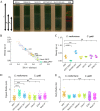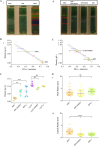The Buoyancy of Cryptococcus neoformans Is Affected by Capsule Size
- PMID: 30404928
- PMCID: PMC6222054
- DOI: 10.1128/mSphere.00534-18
The Buoyancy of Cryptococcus neoformans Is Affected by Capsule Size
Abstract
Cryptococcus neoformans is an environmental pathogenic fungus with a worldwide geographical distribution that is responsible for hundreds of thousands of human cryptococcosis cases each year. During infection, the yeast undergoes a morphological transformation involving capsular enlargement that increases microbial volume. To understand the factors that play a role in environmental dispersal of C. neoformans and C. gattii, we evaluated the cell density of Cryptococcus using Percoll isopycnic gradients. We found differences in the cell densities of strains belonging to C. neoformans and C. gattii species complexes. The buoyancy of C. neoformans strains varied depending on growth medium. In minimal medium, the cryptococcal capsule made a major contribution to the cell density such that cells with larger capsules had lower density than those with smaller capsules. Removing the capsule, by chemical or mechanical methods, increased the C. neoformans cell density and reduced buoyancy. Melanization of the C. neoformans cell wall, which also contributes to virulence, produced a small but consistent increase in cell density. Encapsulated C. neoformans sedimented much more slowly in seawater as its density approached the density of water. Our results suggest a new function for the capsule whereby it can function as a flotation device to facilitate transport and dispersion in aqueous fluids.IMPORTANCE The buoyancy of a microbial cell is an important physical characteristic that may affect its transportability in fluids and interactions with tissues during infection. The polysaccharide capsule surrounding C. neoformans is required for infection and dissemination in the host. Our results indicate that the capsule has a significant effect on reducing cryptococcal cell density, altering its sedimentation in seawater. Modulation of microbial cell density via encapsulation may facilitate dispersal for other important encapsulated pathogens.
Keywords: Cryptococcus neoformans; buoyancy; capsular polysaccharide; yeast density.
Copyright © 2018 Vij et al.
Figures






Similar articles
-
The buoyancy of cryptococcal cells and its implications for transport and persistence of Cryptococcus in aqueous environments.mSphere. 2024 Dec 19;9(12):e0084824. doi: 10.1128/msphere.00848-24. Epub 2024 Nov 27. mSphere. 2024. PMID: 39601568 Free PMC article.
-
Cryptococcus neoformans and Cryptococcus gattii, the etiologic agents of cryptococcosis.Cold Spring Harb Perspect Med. 2014 Jul 1;4(7):a019760. doi: 10.1101/cshperspect.a019760. Cold Spring Harb Perspect Med. 2014. PMID: 24985132 Free PMC article. Review.
-
The Capsule of Cryptococcus neoformans Modulates Phagosomal pH through Its Acid-Base Properties.mSphere. 2018 Oct 24;3(5):e00437-18. doi: 10.1128/mSphere.00437-18. mSphere. 2018. PMID: 30355667 Free PMC article.
-
Variation in Cell Surface Hydrophobicity among Cryptococcus neoformans Strains Influences Interactions with Amoebas.mSphere. 2020 Apr 29;5(2):e00310-20. doi: 10.1128/mSphere.00310-20. mSphere. 2020. PMID: 32350094 Free PMC article.
-
Phenotypic switching of Cryptococcus neoformans and Cryptococcus gattii.Mycopathologia. 2008 Oct;166(4):181-8. doi: 10.1007/s11046-008-9137-9. Epub 2008 Jun 21. Mycopathologia. 2008. PMID: 18568418 Free PMC article. Review.
Cited by
-
Autophagy Regulates Fungal Virulence and Sexual Reproduction in Cryptococcus neoformans.Front Cell Dev Biol. 2020 May 25;8:374. doi: 10.3389/fcell.2020.00374. eCollection 2020. Front Cell Dev Biol. 2020. PMID: 32528953 Free PMC article.
-
Insight into the Mechanisms and Clinical Relevance of Antifungal Heteroresistance.J Fungi (Basel). 2025 Feb 13;11(2):143. doi: 10.3390/jof11020143. J Fungi (Basel). 2025. PMID: 39997437 Free PMC article. Review.
-
Pathogenicity and virulence of Cryptococcus neoformans from an environmental perspective.Virulence. 2025 Dec;16(1):2547090. doi: 10.1080/21505594.2025.2547090. Epub 2025 Aug 14. Virulence. 2025. PMID: 40810603 Free PMC article. Review.
-
A Predicted Mannoprotein Cmp1 Regulates Fungal Virulence in Cryptococcus neoformans.Pathogens. 2020 Oct 24;9(11):881. doi: 10.3390/pathogens9110881. Pathogens. 2020. PMID: 33114434 Free PMC article.
-
Study of Microbial Extracellular Vesicles:Separation by Density Gradients, Protection Assays and Labelling for Live Tracking.Bio Protoc. 2020 Jan 20;10(2):e3502. doi: 10.21769/BioProtoc.3502. eCollection 2020 Jan 20. Bio Protoc. 2020. PMID: 33654729 Free PMC article.
References
-
- Perfect JR. 2000. Cryptococcosis, p 79–93. In Atlas of infectious diseases. Current Medicine Group, London, United Kingdom.
Publication types
MeSH terms
Substances
Grants and funding
LinkOut - more resources
Full Text Sources
